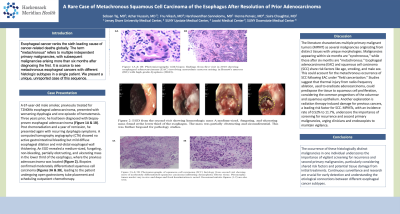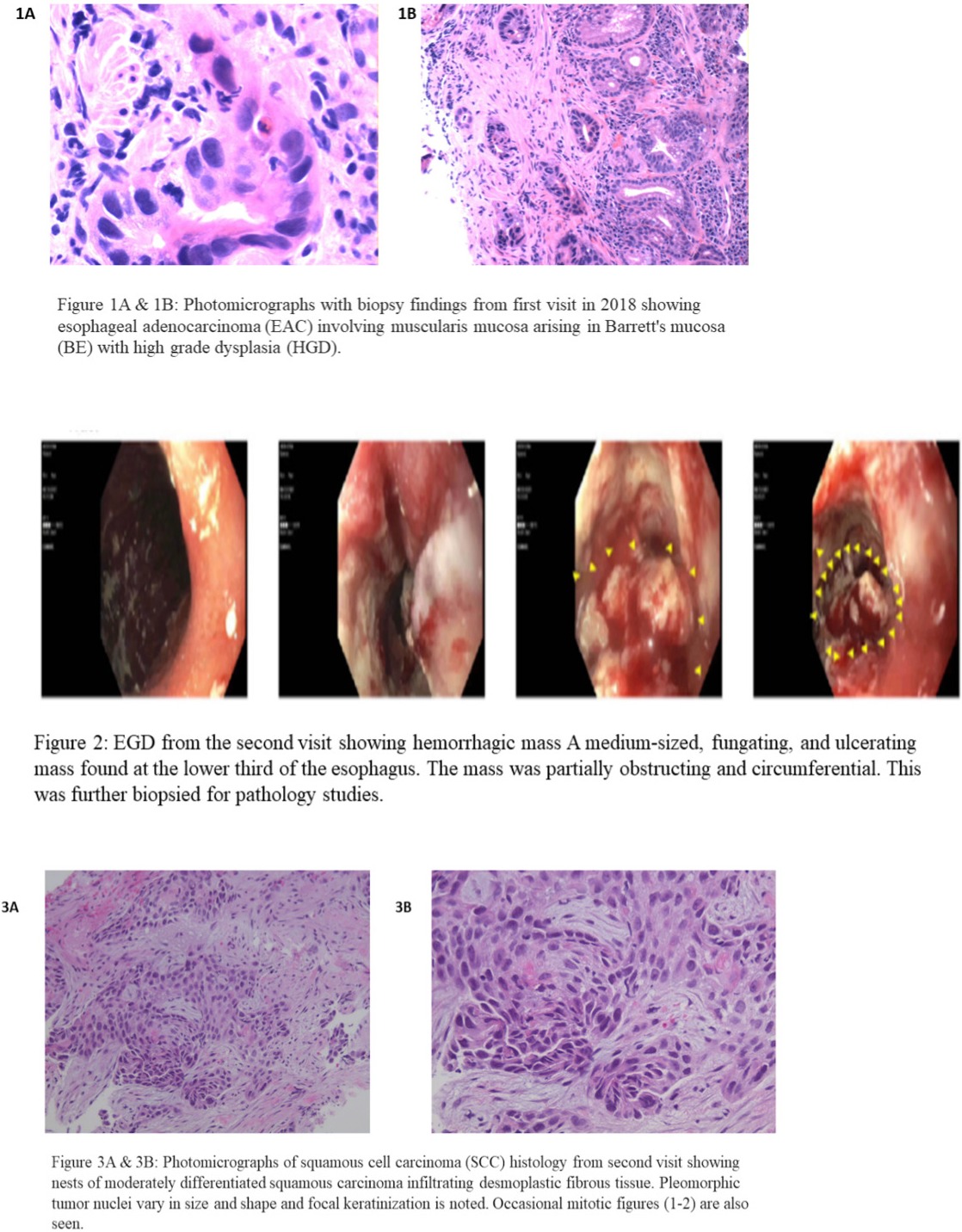Monday Poster Session
Category: Esophagus
P1877 - A Rare Case of Metachronous Squamous Cell Carcinoma of the Esophagus After Resolution of Prior Adenocarcinoma
Monday, October 23, 2023
10:30 AM - 4:15 PM PT
Location: Exhibit Hall

Has Audio

Sobaan Taj, MD
Hackensack Meridian Jersey Shore University Medical Center
Neptune, NJ
Presenting Author(s)
Award: Presidential Poster Award
Sobaan Taj, MD1, Azhar Hussain, MD2, Harshavardhan Sanekommu, MD3, Jayasree Ravilla, MD4, Fnu Vikash, MD5, Henna Pervaiz, MD6, Saira Chaughtai, MD3
1Hackensack Meridian Jersey Shore University Medical Center, Neptune, NJ; 2SUNY Upstate Medical University, New York, Syracuse, NY; 3Jersey Shore University Medical Center, Woodbridge, NJ; 4Monmouth Medical Center/RWJBH, Long Branch, NJ; 5Jacobi Medical Center, Albert Einstein College of Medicine, Bronx, NY; 6SUNY Downstate Medical Center, Brooklyn, NJ
Introduction: Esophageal cancer, primarily manifesting as adenocarcinoma and squamous cell carcinoma, ranks the sixth leading cause of cancer-related deaths globally. The term "metachronous" refers to multiple independent primary malignancies, with subsequent malignancies arising more than six months after diagnosing the first. It is scarce to see metachronous esophageal cancers with different histologic subtypes in a single patient. We present a unique, unreported case of this sequence.
Case Description/Methods: A 67-year-old male smoker, previously treated for T2N0Mx esophageal adenocarcinoma, presented with worsening dysphagia and one episode of hematemesis. Three years prior, he had been diagnosed with biopsy-proven esophageal adenocarcinoma (Figure 1A & 1B). Post chemoradiation and a year of remission, he presented again with recurring dysphagia symptoms. A computed tomography angiography (CTA) showed no active gastrointestinal bleeding but mild diffuse esophageal dilation and mid-distal esophageal wall thickening. An EGD revealed a medium-sized, fungating, non-bleeding, partially obstructing, and ulcerating mass in the lower third of the esophagus, where the previous adenocarcinoma was located (Figure 2). Biopsies confirmed moderately differentiated squamous cell carcinoma (Figures 3A & 3B), leading to the patient undergoing open gastrostomy tube placement and scheduling outpatient chemotherapy.
Discussion: The literature characterizes multiple primary malignant tumors (MPMT) as several malignancies originating from distinct tissues with unique morphologies. Malignancies appearing within six months are "synchronous," while those after six months are "metachronous." Esophageal adenocarcinoma (EAC) and squamous cell carcinoma (SCC) share risk factors like age, smoking, and male sex. This could account for the metachronous occurrence of SCC following EAC under "field cancerization." Studies suggest that thermal injury from radio-frequency ablation, used to eradicate adenocarcinoma, could predispose the tissue to squamous cell proliferation, considering the common progenitors of the columnar and squamous epithelium. Another explanation is radiation therapy-induced damage for previous cancers, a leading risk factor for SCC. MPMTs, with an incidence rate of 0.52% to 11.7%, underscore the importance of screening for recurrence and second primary malignancies, urging clinicians and endoscopists to maintain vigilance.

Disclosures:
Sobaan Taj, MD1, Azhar Hussain, MD2, Harshavardhan Sanekommu, MD3, Jayasree Ravilla, MD4, Fnu Vikash, MD5, Henna Pervaiz, MD6, Saira Chaughtai, MD3. P1877 - A Rare Case of Metachronous Squamous Cell Carcinoma of the Esophagus After Resolution of Prior Adenocarcinoma, ACG 2023 Annual Scientific Meeting Abstracts. Vancouver, BC, Canada: American College of Gastroenterology.
Sobaan Taj, MD1, Azhar Hussain, MD2, Harshavardhan Sanekommu, MD3, Jayasree Ravilla, MD4, Fnu Vikash, MD5, Henna Pervaiz, MD6, Saira Chaughtai, MD3
1Hackensack Meridian Jersey Shore University Medical Center, Neptune, NJ; 2SUNY Upstate Medical University, New York, Syracuse, NY; 3Jersey Shore University Medical Center, Woodbridge, NJ; 4Monmouth Medical Center/RWJBH, Long Branch, NJ; 5Jacobi Medical Center, Albert Einstein College of Medicine, Bronx, NY; 6SUNY Downstate Medical Center, Brooklyn, NJ
Introduction: Esophageal cancer, primarily manifesting as adenocarcinoma and squamous cell carcinoma, ranks the sixth leading cause of cancer-related deaths globally. The term "metachronous" refers to multiple independent primary malignancies, with subsequent malignancies arising more than six months after diagnosing the first. It is scarce to see metachronous esophageal cancers with different histologic subtypes in a single patient. We present a unique, unreported case of this sequence.
Case Description/Methods: A 67-year-old male smoker, previously treated for T2N0Mx esophageal adenocarcinoma, presented with worsening dysphagia and one episode of hematemesis. Three years prior, he had been diagnosed with biopsy-proven esophageal adenocarcinoma (Figure 1A & 1B). Post chemoradiation and a year of remission, he presented again with recurring dysphagia symptoms. A computed tomography angiography (CTA) showed no active gastrointestinal bleeding but mild diffuse esophageal dilation and mid-distal esophageal wall thickening. An EGD revealed a medium-sized, fungating, non-bleeding, partially obstructing, and ulcerating mass in the lower third of the esophagus, where the previous adenocarcinoma was located (Figure 2). Biopsies confirmed moderately differentiated squamous cell carcinoma (Figures 3A & 3B), leading to the patient undergoing open gastrostomy tube placement and scheduling outpatient chemotherapy.
Discussion: The literature characterizes multiple primary malignant tumors (MPMT) as several malignancies originating from distinct tissues with unique morphologies. Malignancies appearing within six months are "synchronous," while those after six months are "metachronous." Esophageal adenocarcinoma (EAC) and squamous cell carcinoma (SCC) share risk factors like age, smoking, and male sex. This could account for the metachronous occurrence of SCC following EAC under "field cancerization." Studies suggest that thermal injury from radio-frequency ablation, used to eradicate adenocarcinoma, could predispose the tissue to squamous cell proliferation, considering the common progenitors of the columnar and squamous epithelium. Another explanation is radiation therapy-induced damage for previous cancers, a leading risk factor for SCC. MPMTs, with an incidence rate of 0.52% to 11.7%, underscore the importance of screening for recurrence and second primary malignancies, urging clinicians and endoscopists to maintain vigilance.

Figure: Pictures are with the captions.
Disclosures:
Sobaan Taj indicated no relevant financial relationships.
Azhar Hussain indicated no relevant financial relationships.
Harshavardhan Sanekommu indicated no relevant financial relationships.
Jayasree Ravilla indicated no relevant financial relationships.
Fnu Vikash indicated no relevant financial relationships.
Henna Pervaiz indicated no relevant financial relationships.
Saira Chaughtai indicated no relevant financial relationships.
Sobaan Taj, MD1, Azhar Hussain, MD2, Harshavardhan Sanekommu, MD3, Jayasree Ravilla, MD4, Fnu Vikash, MD5, Henna Pervaiz, MD6, Saira Chaughtai, MD3. P1877 - A Rare Case of Metachronous Squamous Cell Carcinoma of the Esophagus After Resolution of Prior Adenocarcinoma, ACG 2023 Annual Scientific Meeting Abstracts. Vancouver, BC, Canada: American College of Gastroenterology.

